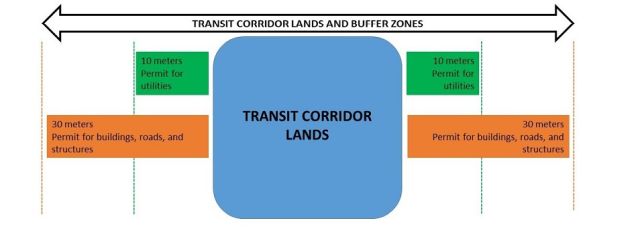The Building Transit Faster Act (the Act) became law in Ontario on July 8, 2020. The purpose of the Act is to address the low transit capacity in the province and to prioritize transit projects by building them on time and within budget.
A way that the Act achieves its purpose is by requiring owners of land and infrastructure located in transit corridors to obtain a permit for any development activities that may interfere with transit construction, failing which, the authority may have certain rights to remove any physical barriers.
How may this Act affect your existing or future property development?
For example, the Act mattered little to the City of Hamilton until a regulation was passed prescribing the Hamilton Light Rail Transit line as a "priority transit project" susceptible to the Act. This means that owners of nearly 3,700 properties within the prescribed Hamilton LRT line now have to obtain a permit before undertaking any development or changes to these properties.
Let's explore what this permit entails.
The Transit Corridor & buffer zones
Land that may be needed for the construction of transit projects is designated as Transit Corridor Lands. A Metrolinx Corridor Development Permit is required for most developments within the Transit Corridor.
Outside of the Transit Corridor, there are two buffer zones. Buffer zones stretch for 30 meters on each side of the Transit Corridor, and development within the buffer zones also requires a permit. A permit is not needed outside of the 30-meter buffer zone.
The first buffer zone is 10 meters from the Transit Corridor and applies to all utility infrastructure. Any work or improvement to the utility infrastructure outside of the 10-meter buffer zone does not require a permit.
The second buffer zone is 30 meters from the Transit Corridor and applies to all buildings, structures, and roads.

To find out if your property or infrastructure is located within the Transit Corridor or buffer zones, please see the map.
Corridor development permit exemptions
Some work on residential and business properties will not require a permit. A non-exhaustive list of work that does not require this permit includes:
- Interior construction within an existing structure such as renovation, restoration, reconstruction or alteration
- Replacing windows, roofing and recladding
- Finishing and repairing an existing basement so long as the basement underpinnings do not exceed a depth greater than 0.5 meters
- Driveway, entryway or pathway repairs or repaving
- Private tree planting
- Temporary tent
- Replacing or installing a fence or uncovered platforms with less than 0.5 meter deep excavation
- Landscaping features with less than 1 meter in height and less than 0.5 meter deep excavation
- Erection of monuments with foundation less than 1.25 meters in depth
A permit will also not be needed to address an emergency. In these instances, municipalities and utility companies may perform work that would otherwise require a permit.
Development that had commenced before lands were designated as a transit corridor is likewise exempt from the permit requirement with one caveat – Metrolinx may impose a permit requirement on existing development with notice to the owner. If work will not be finished within six months of receiving the notice, a permit will be required unless a workable agreement is negotiated and agreed to by Metrolinx.
Metrolinx is in the process of distributing notices to owners and registering a notice of the designation on title of affected properties.
Permits: Components, time, process
For any other work occurring within the Transit Corridor and the 10 or 30-meter buffer zones, a permit shall be obtained according to section 3 of the Act.
Metrolinx, in its Ministerial role, may attach terms and conditions to the permit as necessary. Owners should also be aware that Metrolinx may cancel a permit at its discretion at any time.
Step 1: Pre-application
Applicants are required to submit a Pre-Application Form1 along with a Site Plan showing the proposed project, property lines, and setbacks. If applicable, a topographic survey, grading and site servicing may also be required.2
Metrolinx does not charge any fees to submit and review an application or to issue a permit. But gathering the necessary documents for the pre-application can be time consuming and costly.
Through the pre-application form, Metrolinx may decide to arrange a meeting to facilitate a smoother technical review process. If, however, Metrolinx determines that the proposed project will have no impact on the priority transit process, then no meeting will be necessary. Applicants can then proceed to submit a Corridor Development Permit Application Form and Checklist3.
Step 2: Obtaining a permit
For small-scale and minor projects, owners can expect to hear the decision on the permit from Metrolinx within 20 to 30 business days. To qualify as a small-scale and minor project, it must have little to no impact on the transit project, which means:
- Metrolinx has no property interests
- No ground dewatering, excavation, or shoring work within the geotechnical zone of influence
- No material loading on existing or planned transit works or assets
- No deviation from Metrolinx requirements and standards
- No overlap in schedule or location with a priority transit project
All other projects can expect to hear the decision within 60 business days from the time of submission of the complete application package. If, however, an Applicant does not receive a response within 60 days, they are entitled to commence the Metrolinx Response Review Process according to section 11 of the Act. The review process may take between 20 to 45 business days and longer for complex projects.
The Review Process may also be commenced if a decision on the permit contains i) an error of statutory authority, or ii) the decision is patently unreasonable. Supporting materials for a review process may contain legal analysis or engineer assessments.
Step 3: Executions
If a decision is made to grant the permit but with unfavourable conditions, the Applicant should correspond with Metrolinx to request further discussion or request a review of the conditions. If the Applicant fails to correspond with Metrolinx within 20 business days of the decision, the permit will be issued with existing conditions.
Changes to the permit and its conditions are also possible at a later time and can be accomplished by requesting a Corridor Development Permit amendment.
If the permit expires before the completion of the project, the Applicant will need to seek an extension to the permit. Extensions, however, are issued at the sole discretion of Metrolinx.
Consequences of not abiding by the Act
Failure to obtain a permit or general non-compliance with the Act may result in an administrative penalty. This penalty could reach up to $500,000 and may be enforced alongside other regulatory measures.
Metrolinx holds the authority to impose this penalty without a hearing, denying the non-compliant party an opportunity to defend themselves. Nevertheless, the non-compliant party may request a review of the penalty within 30 days to avoid the penalty becoming due and payable.4
During the review process, any imposed penalty is temporarily suspended until a final decision is made. If a monetary penalty is upheld by the reviewer, it must be paid within 30 days, or the decision may be submitted to the Superior Court of Justice and be treated as a court order under the Court of Justice Act. While the decision is considered conclusive, the possibility of judicial review still exists.
Metrolinx's powers
Property owners should also be aware that besides being able to mandate and make decisions on permits, Metrolinx has the power to alter or remove structures, trees, shrubs, or hedges that are in the way of transit construction. Metrolinx may exercise this power regardless of whether the structure was in place before transit construction began or an owner obtained a permit. This power does not extend to the removal of buildings, roads, or utility infrastructure, but it does extend to partial removal of buildings.
Should a removal or alteration be necessary, Metrolinx will issue a notice and negotiate with owners on how to best approach the removal or alteration. If negotiations fail, Metrolinx may nevertheless enter the property and carry out the necessary removal or alteration. It is therefore in the interest of owners to be reasonable and reach an agreement.
After the work is complete, Metrolinx will undertake reasonable efforts to restore the property, including replanting trees. Restoration, however, may not always be possible, and in such cases, Metrolinx will reimburse owners as long as the removed or altered property was not in violation of any laws, or municipal by-laws, and had the necessary permits to be put up in the first place. Reimbursement is also conditional on owners not having obstructed the alteration or removal. Owners may lose their entitlement to compensation if they did.
In a very similar fashion, if anything on one's property poses an immediate danger to the transit project construction, Metrolinx may enter the property and eliminate the danger by removal or alteration without notice to the owner.
Exercise of these powers by Metrolinx will not constitute an expropriation or injurious affection for the purposes of the Expropriation Act or any other law. Therefore, this may have implications on future claims by property owners against Metrolinx in connection with the expropriation of lands required for transit projects.
Once granted
The Corridor Development Permit does not replace permits and approvals required by other authorities having jurisdiction, like your municipality or local conservation authority among others. Property owners should still seek other permits as necessary.
Depending on the extent of the prospective project, property owners may wish to apply for all necessary permits concurrently, or first obtain the Metrolinx Corridor Development Permit because it is paramount to most other permits.
Footnote
1. Pre-Application form for adjacent development.
Pre-Application form for utilities and roadways development.
2. Metrolinx permit application requirements may not be to the same standard as those of municipalities, conservation authorities, and other jurisdictions.
3. Corridor Development Permit Application Form and Checklist for adjacent development.
Corridor Development Permit Application Form and Checklist for utilities and roadways development.
4. The Act lacks clarity on the designated authority for reviewing administrative penalties. It merely states that reviews will be conducted by a "prescribed individual" in a Minister-approved format, with the actual designation awaiting Regulation. Currently, it is anticipated that reviews may be handled internally by Metrolinx or by the Ministry of Transportation.
Read the original article on GowlingWLG.com
The content of this article is intended to provide a general guide to the subject matter. Specialist advice should be sought about your specific circumstances.

